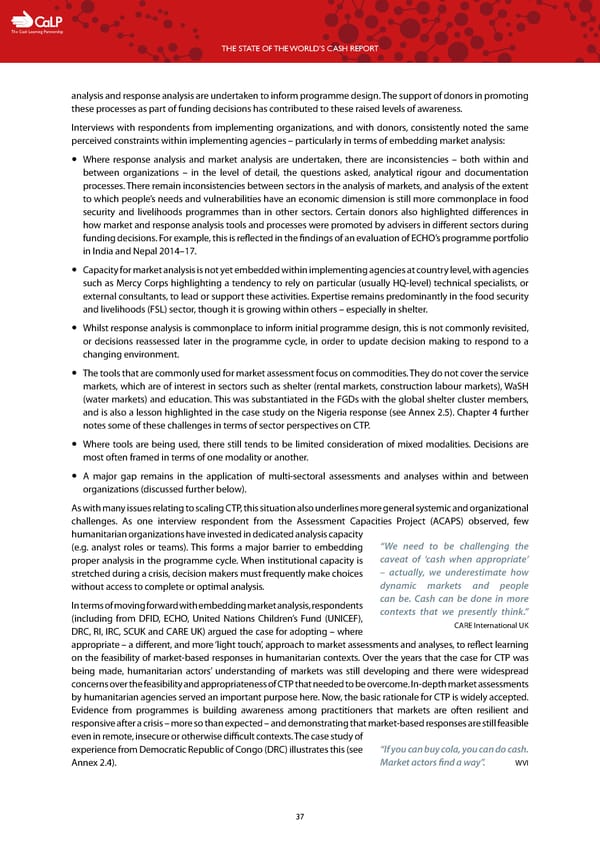C The Cash Learning Partnership THE STATE OF THE WORLD’S CASH REPORT analysis and response analysis are undertaken to inform programme design. The support of donors in promoting these processes as part of funding decisions has contributed to these raised levels of awareness. Interviews with respondents from implementing organizations, and with donors, consistently noted the same perceived constraints within implementing agencies – particularly in terms of embedding market analysis: — Where response analysis and market analysis are undertaken, there are inconsistencies – both within and between organizations – in the level of detail, the questions asked, analytical rigour and documentation processes. There remain inconsistencies between sectors in the analysis of markets, and analysis of the extent to which people’s needs and vulnerabilities have an economic dimension is still more commonplace in food security and livelihoods programmes than in other sectors. Certain donors also highlighted differences in how market and response analysis tools and processes were promoted by advisers in different sectors during funding decisions. For example, this is reflected in the findings of an evaluation of ECHO’s programme portfolio in India and Nepal 2014–17. — Capacity for market analysis is not yet embedded within implementing agencies at country level, with agencies such as Mercy Corps highlighting a tendency to rely on particular (usually HQ-level) technical specialists, or external consultants, to lead or support these activities. Expertise remains predominantly in the food security and livelihoods (FSL) sector, though it is growing within others – especially in shelter. — Whilst response analysis is commonplace to inform initial programme design, this is not commonly revisited, or decisions reassessed later in the programme cycle, in order to update decision making to respond to a changing environment. — The tools that are commonly used for market assessment focus on commodities. They do not cover the service markets, which are of interest in sectors such as shelter (rental markets, construction labour markets), WaSH (water markets) and education. This was substantiated in the FGDs with the global shelter cluster members, and is also a lesson highlighted in the case study on the Nigeria response (see Annex 2.5). Chapter 4 further notes some of these challenges in terms of sector perspectives on CTP. — Where tools are being used, there still tends to be limited consideration of mixed modalities. Decisions are most often framed in terms of one modality or another. — A major gap remains in the application of multi-sectoral assessments and analyses within and between organizations (discussed further below). As with many issues relating to scaling CTP, this situation also underlines more general systemic and organizational challenges. As one interview respondent from the Assessment Capacities Project (ACAPS) observed, few humanitarian organizations have invested in dedicated analysis capacity (e.g. analyst roles or teams). This forms a major barrier to embedding “We need to be challenging the proper analysis in the programme cycle. When institutional capacity is caveat of ‘cash when appropriate’ stretched during a crisis, decision makers must frequently make choices – actually, we underestimate how without access to complete or optimal analysis. dynamic markets and people In terms of moving forward with embedding market analysis, respondents can be. Cash can be done in more (including from DFID, ECHO, United Nations Children’s Fund (UNICEF), contexts that we presently think.” DRC, RI, IRC, SCUK and CARE UK) argued the case for adopting – where CARE International UK appropriate – a different, and more ‘light touch’, approach to market assessments and analyses, to reflect learning on the feasibility of market-based responses in humanitarian contexts. Over the years that the case for CTP was being made, humanitarian actors’ understanding of markets was still developing and there were widespread concerns over the feasibility and appropriateness of CTP that needed to be overcome. In-depth market assessments by humanitarian agencies served an important purpose here. Now, the basic rationale for CTP is widely accepted. Evidence from programmes is building awareness among practitioners that markets are often resilient and responsive after a crisis – more so than expected – and demonstrating that market-based responses are still feasible even in remote, insecure or otherwise difficult contexts. The case study of experience from Democratic Republic of Congo (DRC) illustrates this (see “If you can buy cola, you can do cash. Annex 2.4). Market actors find a way”. WVI 37
 The State of the World's Cash | Full Report Page 38 Page 40
The State of the World's Cash | Full Report Page 38 Page 40